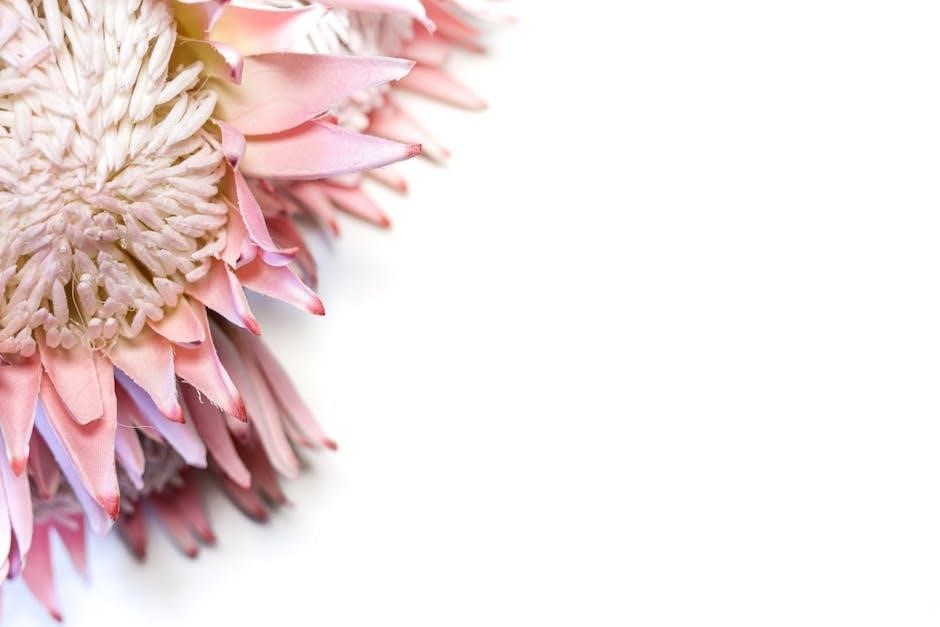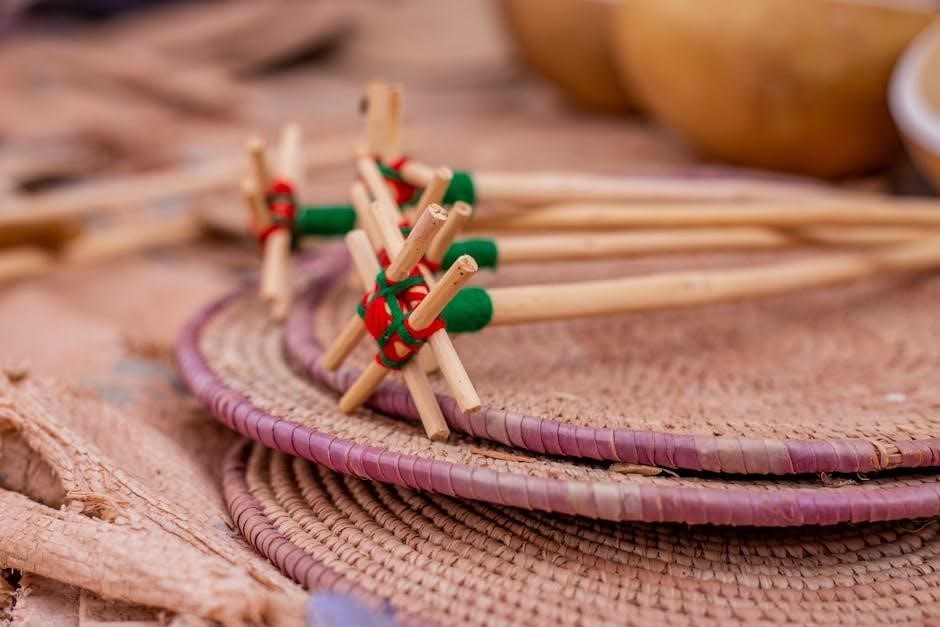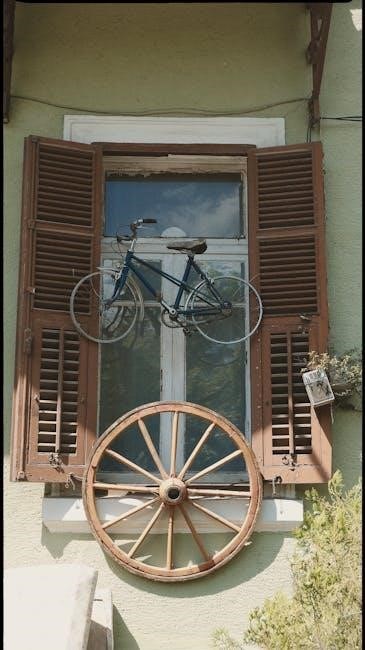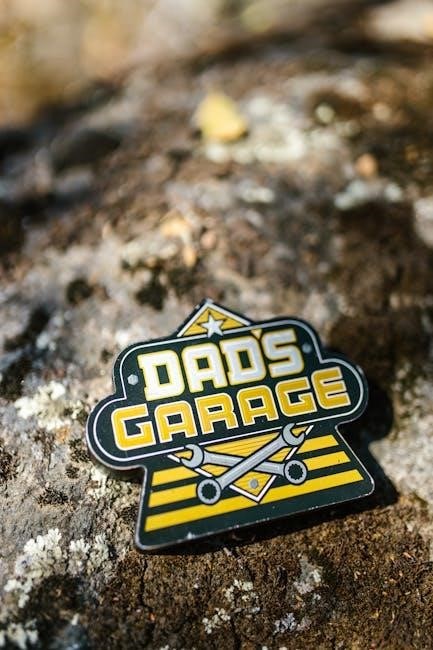The Brownie Design with Nature Badge encourages girls to explore the outdoors while applying math and design thinking skills. Through hands-on activities, such as calculating the age of natural objects, building bird feeders, and creating nature-inspired art, participants develop creativity and problem-solving abilities. This badge fosters a deeper connection with nature while promoting STEM education and teamwork.
1.1 Overview of the Badge and Its Purpose
The Brownie Design with Nature Badge is a unique program designed to connect girls with the natural world while fostering STEM skills. This badge focuses on integrating math, design thinking, and creativity through outdoor activities. It encourages girls to explore nature’s patterns, shapes, and structures, such as bee hives and bird feeders, and apply mathematical concepts to real-world problems. The badge is part of the “Math in Nature” series but can be earned independently, offering flexibility for troops. Its purpose is to inspire curiosity, creativity, and environmental awareness while building confidence in STEM fields. By blending nature and design, the badge provides a hands-on learning experience that makes math and science accessible and fun for young learners.
1;2 Importance of Math and Nature in the Badge Requirements
The Brownie Design with Nature Badge uniquely combines math and nature to help girls develop essential STEM skills through hands-on activities. Math is used to solve real-world problems in nature, such as calculating the age of trees or measuring bird feeders. This integration fosters a deeper understanding of how mathematical concepts apply to the environment. Nature provides a dynamic classroom where girls can explore patterns, shapes, and structures, inspiring creativity and curiosity. By blending these elements, the badge encourages girls to see math as a tool for problem-solving and design thinking in the natural world. This approach not only enhances math proficiency but also cultivates an appreciation for nature and its interconnected systems.

Requirements for Earning the Brownie Design with Nature Badge
Earning the badge involves using math in nature, exploring shapes, and designing projects like bird feeders. Hands-on activities foster creativity and problem-solving skills while connecting with the outdoors.
2.1 Requirement 1: Calculate the Age of a Natural Object
This requirement introduces girls to using math to understand the natural world. They learn to calculate the age of objects like trees by counting growth rings, applying basic arithmetic and observation skills. This activity connects math with nature, fostering curiosity and environmental awareness while encouraging STEM exploration. Girls develop critical thinking and problem-solving abilities through hands-on learning. The exercise also highlights the importance of nature as a living classroom, where math is a tool for discovery. By engaging with their surroundings, participants gain a deeper appreciation for the interconnectedness of math and the environment, laying a strong foundation for future STEM endeavors and environmental stewardship. This activity is both educational and inspiring, making math accessible and fun in an outdoor setting.
2.2 Requirement 2: Explore the Shape of Beehives and Build a Honeycomb
This requirement focuses on understanding the geometric patterns found in nature, specifically the hexagonal shapes of beehives. Girls learn about the efficiency of these structures and how they are formed by bees. They then apply this knowledge to build their own honeycomb model using materials like clay, paper, or 3D printing. This activity introduces concepts of geometry and design thinking, encouraging girls to appreciate the mathematical precision in natural systems. By exploring the shapes of beehives, participants gain insights into the practical applications of math in nature and develop their creativity and problem-solving skills. This hands-on project fosters curiosity about the natural world while reinforcing STEM principles in a fun and engaging way.
2.3 Requirement 3: Measure and Build a Bird Feeder
In this requirement, girls apply math skills to design and construct a bird feeder that supports local wildlife. They begin by measuring materials like wood, seeds, and rope to ensure the feeder’s dimensions suit various bird species. Using tools such as hammers and screwdrivers, they assemble the feeder, learning about proportions and practical engineering. This activity teaches girls about bird behavior, the importance of wildlife conservation, and the value of creating sustainable solutions. By building a bird feeder, participants engage in hands-on learning, fostering their creativity and appreciation for nature. This project also encourages girls to observe and interact with their environment, promoting environmental stewardship and community involvement. The process reinforces math concepts while connecting them to real-world applications.
2.4 Requirement 4: Design a Campout Plan Using Nature
For this requirement, girls create a detailed campout plan that incorporates elements of nature and outdoor activities. They begin by selecting a suitable location, considering factors like hiking trails, camping facilities, and access to natural attractions. Girls then outline a schedule, including meal planning, outdoor games, and nature-based activities such as bird-watching or stargazing. They also learn to identify and use natural resources responsibly, such as gathering firewood or purifying water. The plan encourages teamwork, as girls collaborate to ensure safety, sustainability, and fun. By designing a campout, participants develop organizational skills, environmental awareness, and a deeper appreciation for nature. This requirement helps girls become confident outdoor leaders while fostering a sense of adventure and community. The final plan reflects their creativity and understanding of nature’s role in their lives.
2.5 Requirement 5: Create a Nature-Inspired Art Project

This requirement encourages girls to express their creativity by creating an art project inspired by nature. They can use natural materials like leaves, rocks, or twigs to craft unique designs or patterns. Girls might create nature-themed paintings, sculptures, or collages that reflect their observations of the outdoor world. The project fosters an appreciation for nature’s beauty and diversity while promoting self-expression. Girls can also experiment with photography, capturing natural scenes or textures to incorporate into their artwork. This activity helps develop fine motor skills, imagination, and an understanding of how art and nature intersect. The final project serves as a meaningful keepsake, reminding girls of their connection to the environment and the joy of creating something beautiful from the world around them.

Skills and Concepts Learned Through the Badge
Girs develop math skills, creativity, and problem-solving abilities while exploring nature. They learn design thinking, environmental stewardship, and teamwork, fostering confidence and a deeper connection to the natural world.
3.1 Developing Math Skills in Nature
Earning the Brownie Design with Nature Badge introduces girls to practical applications of math skills in the natural world. Activities like calculating the age of trees, measuring bird feeders, and exploring geometric patterns in beehives encourage an understanding of real-world numerical concepts. Girls learn to apply arithmetic, geometry, and measurement techniques in outdoor settings, fostering a connection between abstract math and tangible nature. This hands-on approach helps build curiosity and confidence in STEM fields while making learning fun and relevant. By integrating math into nature-based projects, the badge inspires girls to see the practical applications of math in everyday life and environmental exploration.
3.2 Understanding the Role of Design Thinking in Nature
Earning the Brownie Design with Nature Badge introduces girls to the concept of design thinking through nature-based activities. Design thinking involves observing problems, brainstorming solutions, and creating prototypes, which aligns perfectly with nature’s inherent creativity. Activities like building bird feeders or designing campouts encourage girls to think critically about how to meet the needs of wildlife or plan outdoor experiences. By studying natural patterns, such as the structure of honeycombs or the shapes of leaves, girls gain inspiration for innovative designs. This process fosters empathy, creativity, and problem-solving skills, helping them see nature as a source of endless ideas and solutions. Through this badge, girls learn to apply design thinking to real-world challenges, fostering a deeper appreciation for nature’s role in innovation.

3.3 Building Creativity and Problem-Solving Abilities
Earning the Brownie Design with Nature Badge helps girls develop their creativity and problem-solving skills through engaging, nature-based activities. By exploring the natural world, girls learn to observe, brainstorm, and implement solutions to real-world challenges. For instance, designing a bird feeder requires measuring, calculating, and constructing, which enhances spatial reasoning and critical thinking. Similarly, creating nature-inspired art projects encourages girls to experiment with materials and ideas, fostering imagination and self-expression. These experiences teach girls to approach problems innovatively and confidently, preparing them to tackle challenges in everyday life. The badge emphasizes hands-on learning, allowing girls to see the practical applications of creativity and problem-solving in nature and beyond.

Resources and Activities for Completing the Badge

Useful tools, materials, and online guides are available to help girls complete the badge requirements, including workshops, PDF resources, and hands-on nature-based activities designed for Brownies.
4.1 Recommended Tools and Materials for Activities
For the Brownie Design with Nature Badge, essential tools include measuring tapes, calculators, and magnifying glasses for analyzing natural objects. Materials like wood, nails, and bins are ideal for building bird feeders. Art supplies such as paints, glue, and recycled materials encourage creativity in nature-inspired projects; Additionally, hammers, safety goggles, and eco-friendly items like pinecones and leaves are useful for hands-on activities. Troop leaders should ensure access to these resources to facilitate learning and fun for the girls.
4.2 Workshop Ideas for Troops to Earn the Badge
Organize hands-on workshops where girls can explore nature and apply math skills. Start with a campout planning session, where troops design a campout itinerary using natural resources. Host a bird feeder workshop, providing materials for girls to measure and build their own feeders. Include a nature scavenger hunt to identify shapes and patterns in the environment. Offer a design thinking activity where girls create nature-inspired art using recycled materials. Plan a field trip to a local nature reserve for hands-on exploration. Incorporate teamwork-building exercises, such as collaborative honeycomb constructions or group art projects. These workshops will engage girls in meaningful learning while fostering creativity and a connection with nature.
4.3 Online Guides and PDF Resources Available
Several online guides and PDF resources are available to help troops earn the Brownie Design with Nature Badge. The official Girl Scouts website offers a detailed pamphlet tailored for this badge, providing step-by-step instructions for each requirement. Additionally, Badge Explorer and Nature Scapes offer comprehensive guides that align with the badge’s objectives. These resources include activity plans, math exercises, and design templates to assist troop leaders in organizing workshops. Many PDF guides are downloadable, featuring ideas for nature-inspired art projects, bird feeder designs, and campout planning. Troops can also access interactive workshops and webinars through platforms like Zoom, which cover key requirements like calculating the age of natural objects and exploring beehive shapes. These resources ensure a fun and educational experience for participants.

Tips for Troop Leaders and Participants
Encourage girls to observe nature closely and use math creatively. Promote teamwork during activities like building bird feeders or designing campouts. Emphasize fun and learning in nature.

5.1 Planning Effective Nature-Based Activities
Planning nature-based activities for the Design with Nature Badge requires creativity and preparation. Leaders should involve girls in decision-making to foster engagement. Choose locations with diverse natural elements, ensuring safety and accessibility. Incorporate hands-on tasks like measuring trees or designing bird feeders to align with badge requirements. Encourage observation and reflection to deepen learning. Balance structured activities with free exploration time, allowing girls to connect with nature at their own pace. Provide necessary materials and tools, and consider weather conditions to ensure a positive experience. By integrating math, design, and teamwork, these activities help girls develop STEM skills while appreciating the outdoors;

5.2 Encouraging Teamwork and Creativity in Girls
Encouraging teamwork and creativity is essential for girls earning the Design with Nature Badge; Collaborative activities, such as designing a campout plan or building a bird feeder, foster problem-solving and idea sharing. Leaders should create opportunities for girls to reflect on their projects, celebrating their unique contributions. Group brainstorming sessions can spark innovation, while hands-on tasks allow girls to express their creativity. Providing diverse materials and open-ended challenges inspires imaginative thinking. Encouraging girls to support and learn from one another strengthens their confidence and collaboration skills. By promoting a positive and inclusive environment, troop leaders help girls develop a growth mindset and a deeper appreciation for nature and design.
Earning the Brownie Design with Nature Badge is a rewarding experience that combines math, nature, and creativity. Girls gain essential skills in problem-solving, design thinking, and teamwork while exploring the natural world. The badge fosters a deeper appreciation for nature and encourages girls to think innovatively about the environment. By completing activities like calculating the age of natural objects, building bird feeders, and creating nature-inspired art, girls develop confidence and a sense of accomplishment. This badge not only enhances their STEM knowledge but also inspires them to become stewards of the environment. Troop leaders play a crucial role in guiding girls through these activities, ensuring a fun and educational journey that leaves a lasting impact on their lives and the world around them.
